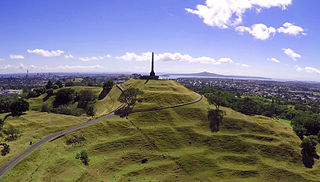
The Aotearoa Music Awards, conferred annually by Recorded Music NZ, honour outstanding artistic and technical achievements in the recording field. The awards are among the most significant that a group or artist can receive in New Zealand music, and have been presented annually since 1965. The awards show is presented by Recorded Music NZ. A range of award sponsors and media partners support the event each year.

Maungakiekie / One Tree Hill is a 182-metre (597 ft) volcanic peak and Tūpuna Maunga in Auckland, New Zealand. It is an important place culturally and archeologically for both Māori and Pākehā. The suburb around the base of the hill is also called One Tree Hill. It is surrounded by the suburbs of Royal Oak to the west, and clockwise, Epsom, Greenlane, Oranga, and Onehunga. The summit provides views across the Auckland area, and allows visitors to see both of Auckland's harbours.
The Ockham New Zealand Book Awards are literary awards presented annually in New Zealand. The awards began in 1996 as the merger of two literary awards events: the New Zealand Book Awards, which ran from 1976 to 1995, and the Goodman Fielder Wattie Book Awards, which ran from 1968 to 1995.
New Zealand Māori rugby league team is a rugby league representative side made up of New Zealand Māori players. The side represents the New Zealand Māori Rugby league. Like its union counterpart, the rugby league team competes in international competitions.

Sir Frederick Miles Warren was a New Zealand architect. He apprenticed under Cecil Wood before studying architecture at the University of Auckland, eventually working at the London County Council where he was exposed to British New Brutalism. Upon returning to Christchurch, and forming the practice Warren and Mahoney, he was instrumental in developing the "Christchurch School" of architecture, an intersection between the truth-to-materials and structural expression that characterised Brutalism, and the low-key, Scandinavian and Japanese commitment to "straightforwardness". He retired from Warren and Mahoney in 1994 but continued to consult as an architect and maintain his historic home and garden at Ohinetahi.

Tessa Duder is a New Zealand author of novels for young people, short stories, plays and non-fiction, and a former swimmer who won a silver medal for her country at the 1958 British Empire and Commonwealth Games. As a writer, she is primarily known for her Alex quartet and long-term advocacy for New Zealand children's literature. As an editor, she has also published a number of anthologies.
Humphrey John Ikin is a New Zealand furniture designer.

David Geoffrey Trubridge is a furniture designer based in Whakatu, New Zealand.

Sir Harawira Tiri Gardiner was a New Zealand soldier, public servant, and writer. He was Māori, of Ngāti Awa, Ngāti Pikiao, Whakatōhea, and Te Whānau-ā-Apanui descent.
Ronald Fong Sang was a New Zealand architect, art collector, art exhibitor and publisher of New Zealand art books.
Atamira Dance Company is a Māori contemporary dance company in Aotearoa based in Auckland.
Noeline Brokenshire was a New Zealand sportswoman, who represented her country in field hockey, and as a hurdler at the 1950 British Empire Games. Later she was a gallery owner and noted woodturner, and the founder and publisher of New Zealand's first woodworking magazine, Touch Wood.
Saradha Koirala is a New Zealand poet and writer based in Melbourne, Australia. She is the author of three poetry collections and two Young Adult novels. Koirala also writes literature reviews and has interviewed international authors and covered events such as the Auckland Writers & Readers Festival. She was the convening judge for the Mary and Peter Biggs Award for Poetry in the 2022 Ockham New Zealand Book Awards.

Rebecca Katherine Priestley is a New Zealand academic, science historian, and writer. She is an Associate Professor in Science in Society at Victoria University of Wellington.
Ruth Buchanan is a contemporary Aotearoa New Zealand artist of Te Āti Awa, Taranaki and Pakeha decent. Buchanan was born in Ngamotu New Plymouth and grew up in Poneke Wellington. She lives and works in Berlin.
Vasanti Unka is a New Zealand writer, illustrator and graphic designer who has been involved in the book and magazine industry for many years. A number of her books have been shortlisted for awards and she won Best Picture Book and Margaret Mahy Book of the Year Award at the 2014 New Zealand Post Book Awards with The Boring Book. She lives in Auckland, New Zealand.

Tina Makereti is a New Zealand novelist, essayist, and short story writer, editor and creative writing teacher. Her work has been widely published and she has been the recipient of writing residencies in New Zealand and overseas. Her book Once Upon a Time in Aotearoa won the inaugural fiction prize at the Ngā Kupu Ora Māori Book Awards in 2011, and Where the Rēkohu Bone Sings won the Ngā Kupu Ora Aotearoa Māori Book Award for Fiction in 2014. She lives on the Kapiti Coast, New Zealand.
Celia Allison is a New Zealand illustrator, best known for creating the character Cecily.

Fergus George Frederick Sheppard was a New Zealand architect, who served as the chief government architect from 1959 until his retirement in 1971. During his time in this capacity he was involved with the design of the Beehive, among hundreds of other public buildings.
Gina Cole is a New Zealand writer and lawyer. Her writing is inspired by her experiences as a queer Fijian woman. Her short story collection Black Ice Matter received the award for best first book of fiction at the 2017 Ockham New Zealand Book Awards. Her first novel Na Viro was published in July 2022.









